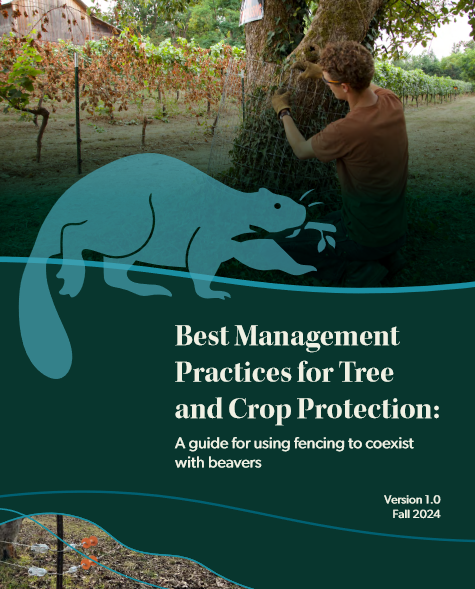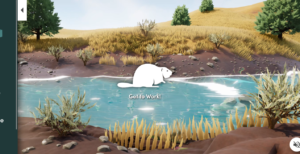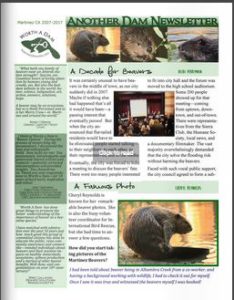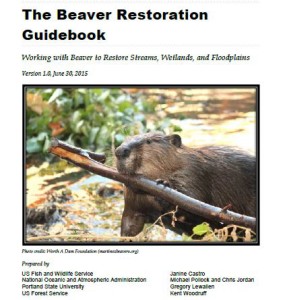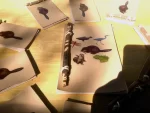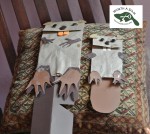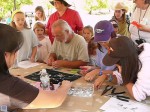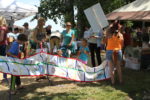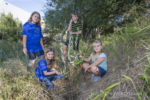
Sure we might have worked two solid years researching the nativity of beavers in the sierras, and sure Rick bought every historical volume from Aubrey to Zeiner but even though the papers were published with almost no challenges, and even through the editors at fish and game thanked us personally for our hard work, they might easily have gone unnoticed by everyone in the scientific community who isn’t a regular reader of this website. No one might have known. If a beaver-chewed tree falls in the forest and no one hears it – well, you know how it goes.
What we needed was some massive regional event, pitting beaver nativity against a large scale federal agency. Highlighting in stark profile the issue that beavers were once native in all the places where they’re now routinely killed. We needed a local advocate, some fantastic spokeswoman to sound sincere but intelligent, a white-hat who knows better. We needed a vocal non-believer, and maybe someone salt-of-the-earthy like a farmer or a trout fisherman. But where are we going to get a money shot like that? What are the odds that such a tempest in a tea pot will boil over just when we need it? Sure we could hire actors to stage this whole drama hope some news crews picked it up, but that takes cash and production value. And where are we possibly going to find actors to play the crazy federal nay-sayers, to say that beavers aren’t native over 1000 feet? No one could pull that line off believably.
Sometimes all your prayers are answered.
LAKE TAHOE – To Sherry Guzzi, the beaver dam on Taylor Creek was more than a watery jungle of sticks and branches. In that snarl of debris, she saw hope for a species long regarded as non-native in the Sierra but which new research claims has occupied the range for centuries and is key to ecosystem health. Late last month, her hope was extinguished when the U.S. Forest Service tore down the dam to protect a tourist facility celebrating a non-native species: kokanee salmon.
“They are doing all this to showcase an introduced species,” said Guzzi, co-founder of the Sierra Wildlife Coalition, a local environmental group. “It’s a little nuts, isn’t it?” The Forest Service, which is holding its 23rd Kokanee Salmon Festival this weekend, defended the action. But spokeswoman Cheva Heck said the agency hopes to make its facilities and festival more beaver-friendly in the future.
And that, ladies and gentlemen, is the best setup for announcing beaver research that you will ever have. To remind you, Sherry Guzzi and Mary Long are the women who were trying to save the beavers in Kings Beach a few years back. Worth A Dam gave them a scholarship and they founded the Sierra Wildlife Coalition and have been working installing flowdevices all over the sierras. Now the stage is set, bring in the scientist.
What’s happening here is more than a flap over a furry, flat-tailed rodent with a penchant for gnawing down trees and damming up streams. It is part of a wider controversy over the role of beaver in nature and their provenance – native, non-native or both? – in the Sierra Nevada.
“A beaver can go 10 kilometers by land or 50 kilometers by water in a day. What would keep them out of the Sierra?” said Richard Lanman, a historical ecologist from Los Altos and co-author of two new studies concluding beaver occupied the range long before settlers arrived.
“Every mountain range from northern Mexico to the Arctic tundra, from the Atlantic to the Pacific” had beaver, Lanman said. “And they were supposedly never native to the Sierra? This makes no sense.”Lanman and his colleagues also write that beavers help “fish abundance and diversity in the Sierra Nevada” and their dams “reduce (the) discharge of nitrogen, phosphorus and sediment loads into fragile w” ater bodies such as Lake Tahoe.”“!
Rick Lanman historical ecologist! Sometimes referred to on this website as our friend “Wikipedia Rick”. He became interested in the nativity issue for the very local reason that he purchased his home from an 80 year-old gentleman who said that he used to be able to ‘fly-fish’ in the stream behind his house all year round. Of course that stream was now ephemeral and Rick wondered if beavers might have something to do with it, but was of course assured by the authorities that they ‘weren’t native there’.
Rick wrote me years ago and we got chatting about beavers and where they belonged. I met a USFS hydrologist at the Flyway Festival who was interested in proving beavers were native in the sierras because they were useful for meadow creation. He introduced me to Chuck James the archeologist who had carbon tested the dam in Plumas county, and a cluster of us started work on the research.
“They have a right to be here,” said Heidi Perryman, founder of Worth A Dam, a beaver conservation group in Martinez. “There is a way to manage their difficult behavior. And there is a reason why you should bother to do it.”
“Killing them is an extreme response to managing their behavior,” she added. “It’s like shooting all the cars that speed. It would work, but at what cost?”
Perryman is one of the researchers whose articles in California Fish and Game, a peer-reviewed scientific journal, challenge the long-held view that beaver did not inhabit the Sierra above 1,000 feet on the west slope.
Some of the most persuasive evidence in the articles comes from a beaver dam found buried along a creek in Plumas County. Samples sent to a laboratory for radio-carbon dating showed the structure was built at the dawn of the Middle Ages, around A.D. 580, and used and reused until around 1850.
Did anyone else just hear a crescendo? What a delicious lead-in to a scientific paper that would otherwise only be dustily published in a journal nobody ever heard of! Fantastic writing by Knudson, who wrote the USDA articles published earlier. If Galileo had just had a good reporter working on his side, maybe that whole helio-centrism thing might have gone better for him.
In recent days, the Taylor Creek beavers have been busy with matters of their own – gnawing down more aspen and willows to repair the dam the Forest Service tore down. By Thursday, the dam had been rebuilt. But when Guzzi returned to the site Friday, she said it had been destroyed again.
“On some level, (the Forest Service) must realize how ludicrous a situation this is,” said Guzzi. “It’s so counterproductive. They are wasting tax dollars and harassing an animal that is good for the lake and its clarity.”
And that is as good as a button as you are ever going to get out of a beaver article in the northern hemisphere. Great work Sherry! And great work Rick! Great work Thomas Knudson for seeing the forest for the beaver-chewed trees and working the recent publication into your story! It was January 24, 2010 (‘‘Don’t cause a Nativity Scene“) when I first posted about this issue and just the next month met the hydrologist from USFS at the Flyway Festival, tracked down Chuck’s phone number, and had a thrilling phone call that became a ride on the tail of a leaping dragon from there. Not a bad result for two years of effort.
Also in that picture (and not in the article but hugely important to the process) are Brock Dolman (center) Mary Long (beside Sherry) Lisa Owens Viani (beside Mary) and Eli Asarian (one ‘s’) who did the watershed figure for the article. Every other person not mentioned you can be sure you’re hear about soon.
All in all a great delivery for a pretty timely message. Go, team California, go!
And late breaking news: the California Department of Fish and Game will soon be called the California Department of Fish and Wildlife! That calls for a celebration!







